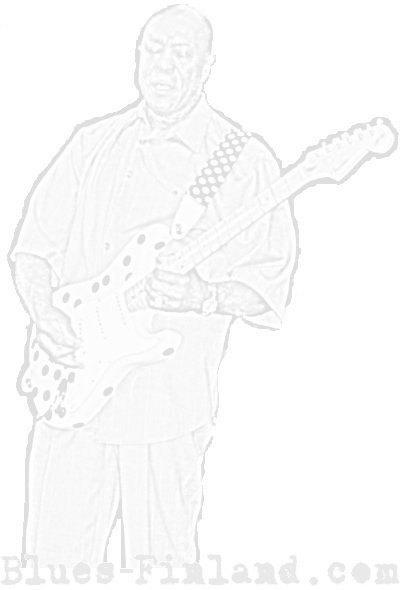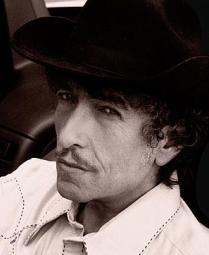 |
| Contact: admin (a) blues-finland.com © 2008 Blues-Finland.com |
| Bob Dylan Was Here 11 June 2008 No, they didn't take a bow. Instead, when it was all over, Bob Dylan And His Band lined up on the edge of the stage, arranging their ranks in the darkness. A hand gesture from the man brought the lights up - and there they stood in their sharp suits and black Stetsons, facing the spotlights, blinking but victorious, the crowd at their feet. "Take a good hard look at these faces," Dylan seemed to be saying, "and then go home and tell everybody it was Bob Dylan And His Gang." For someone rumoured to be not the greatest of actors, Dylan sure has a fine taste for the cinematic. Even without the backdrop of clearing gunsmoke and the remains of a rickety stagecoach, it was a wonderful image - a reminder of America that once was, the America most people seem only too eager to forget about in these politically enraging times. Indeed, I've often wondered if the term "Americana" was coined solely for the lack of an all-inclusive euphemism for "Dylan music"... |
 |
| Thunder On The Mountain But back to the show. There were six people on the stage, but most of the joy and music seemed to emanate from three: Bob Dylan on vocals, keyboard and harmonica, Tony Garnier on electric and upright bass, and George Receli on drums. In the case of Don Herron on guitar, lap steel, violin and banjo, it may have been that the odds were simply not in his favour - as an all-too-common surprise in Estonia, his contributions were mostly lost in the mix; while the lap steel was audible enough, the considerable number of tunes that featured him on violin left the audience wondering what they might have sounded like, had one actually been able to hear the violin... Guitarists Stu Kimball and Denny Freeman were at their best on the more "complicated" tunes, the ones with a decidedly non-blues structure - a bit odd, really, considering Freeman's notable blues pedigree, but then Dylan has never been your average blues performer. One of the most haunting re-arrangements of the evening was undoubtedly "All Along The Watchtower", and it was intriguing to hear Freeman’s take on it - namely, which bits from the Hendrix version he chose to include, as opposed to all the Dylan guitar slingers before him. Another number on which both Freeman and Kimball excelled was "Thunder On The Mountain": the rare sensation of six people on stage living, breathing and rocking as one is never short of mesmerizing. While Kimball stayed in the background for most of the show both visually and aurally, it was nevertheless his acoustic that lent the sound a large chunk of its definitive dylanesqueness – almost as if he was the Chosen One, called up to fill the sonic void left by Dylan’s switch to keyboards. And yes, the second vital ingredient to that signature ”wild mercury sound” was the man's own keyboard playing - admittedly, I'd heard contradicting rumours about Dylan’s current command of his original instrument of choice, but at least for this night, it was all perfect, and by the morning after, it had become very, very hard for me to imagine any other versions of "Stuck Inside Of Mobile With The Memphis Blues Again", "Positively 4th Street", and "Just Like A Woman"... Except I vaguely seem to recall that there have been several. Stuck Inside Of Mobile Yet another positive surprise was Dylan's extensive use of the harmonica, which has been scarcely in evidence on his more recent albums. No longer restricted by his legendary harmonica holder, Dylan’s harp playing in Tallinn was skilful and arrestingly emotional. And then there were the vocals – just like Tom Waits, Dylan seems in complete control over the rasp in his voice, going from a harsh bark to crooning beauty at will. I may be reading too much into it, but it seems he has reserved his rawest voice for ballads he’s grown slightly weary of performing – with ”If You See Her, Say Hello”, it took me four lines into the first verse to realize which song it was, and he hadn’t even fiddled with the words much! Throughout the show, the lines Dylan chose to emphasize seemed well-suited for the occasion – take ”Honest With Me”, for example: ”I won’t come here no more if it bothers you” – yes! For every member of the audience that had stormed out of the seats and was crowding the stage before the opening number was through, there was at least one prominent citizen looking on in horror, feeling cheated out of the sort of cabaret spectacle that passes for rock these days. ”I'm not sorry for nothin' I've done” – even in Tallinn in 2008, a certain segment of the audience would profess a distaste for most things Mr. Zimmerman has occupied himself with since 1964. Ironically, not many of the Tallinn folkies would have caught the quote in his next line, “I'm glad I fought - I only wish we'd won”, weaved in from the post-Civil War anti-Reconstruction Southern anthem “Good Old Rebel” that also includes notions such as “I hate the Yankee nation and everything they do, I hate the Declaration of Independence, too…” Oh - incidentally, Estonian folk music activists maintain that traditional American music other than that of Native Americans is a contradiction in terms, for there is no other American ethnicity – there are just people of various ethnic origins, living in the US of A, therefore all still fully and thoroughly represented by the music of the distant homeland their ancestors left behind 300-400 years ago. Rollin’ & Tumblin’ Rant over – Dylan’s improvisations in Tallinn had more to do with rhythm and phrasing than with rewriting the lyrics, and nowhere more exuberantly so than on “Summer Days”. Facing the two veterans of his band, Garnier (since 1989) and Receli (since 2001), the Lead Singer would alter the phrasing with each verse, with the rhythm section reacting instantly, thus propelling Dylan further and further into ever wilder variations of timing. By the end of song, the group had ran the textbook of 1950’s rock’n’roll patterns cover to cover, from Bill Haley up, as the infectious joy at the noise they were creating filled the room – yes, there was no “official” stage show, but at this point even Garnier got lured into spinning his bass fiddle in grand Bill Black fashion. And Receli on the drums was just a monster. Adept at weaving quiet, intricate patterns into the slower stuff, he packed a punch that allowed him to use his left hand for adjusting his hat throughout the first song, the drum-heavy “Rainy Day Women”. When Dylan stretched the structure of “Honest With Me” by adding extra pauses between most lines and yet insisting on keeping the inter-verse riff in standard time, Receli retorted by seemingly inserting a different rhythmic pattern over each bar of the shuffle. But it was “Rollin’ And Tumblin’” that leaped the furthest of all – the recorded version on “Modern Times” had been appealingly ragged, but what ensued on stage was pure madness and magic. It seemed as if no two verses of the old blues standard contained the same number of bars, a feat rarely attempted even by one-man-and-a-guitar acts other than Kokomo Arnold or Robert Johnson, but to go for it with a six-piece band and to actually pull it off, with the occasional guitar player tangled in the changes only adding spice to the stew… No wonder Dylan calls it the best band he’s ever had! And at the centre of this miracle sat Receli, one eye on his boss, the other on Garnier, sounding the bell to call home the runaway herd, a split second ahead of each verse. It reminded me so much of the early 20th century New Orleans jazz drummers Mezz Mezzrow raved about, I had to Google the guy: “Receli, George - native of New Orleans”. Right. For Charley Patton In 1962, the liner notes for Dylan’s debut album described him as “one of the most compelling white blues singers ever recorded”; a year later he admitted on the sleeve of “Freewheelin’ Bob Dylan”: “I don't carry myself yet the way that Big Joe Williams, Woody Guthrie, Leadbelly and Lightnin' Hopkins have carried themselves. I hope to be able to someday, but they're older people.” It’s 2008 now, and the prophecy has come true. For Bob Dylan’s Tallinn show was very much a blues show, a revue of American music if you please, and Dylan’s now one of the few vocalists on the scene who can legitimately be termed a lead singer – like Muddy Waters, he directed and dictated the music and the tempo with his voice, his timing, and like the blues bands of old, his group did not follow the drummer or the rhythm section or – God forbid – a written arrangement. It was all very loose and very much together, with each member of the band pitching in to comment and collaborate on the story he was telling. The way it ought to be done. Of course, the questions remain: why wasn’t Herron wearing a hat? How can you use the words, tune and instrumentation of “High Water” and end up with a different song? Why was Receli allowed to walk on stage with a lit cigarette when in Scotland, they almost arrested Keith Richards for that? Did Dylan choose to end the show with “Blowing In The Wind” because they told him it was the only Dylan song most of us Estonians know, even if only as a cover version translated into a strange Finno-Ugric language? Does he still have kin in Lithuania? Why did he choose to perform “John Brown” (“John Brown went off to war to fight on a foreign shore, his mama sure was proud of him…”) for MTV Unplugged during the Gulf War and now again in St. Petersburg, Russia of all places? What does the huge Masonic Eye have to do with everything? And will he ever be back? I sure hope so. Now go home and tell everybody that Bob Dylan And His Gang were here. ANDRES ROOTS Bob Dylan & His Band. Estonia, Tallinn, Saku Arena, 4 June 2008 Bob Dylan (vocals, keyboards, harmonica), Tony Garnier (electric and double bass), George Receli (drums), Don Herron (guitar, lap steel, violin, banjo), Stu Kimball (guitar), Denny Freeman (guitar) Set list from Tallinn Links: Bob Dylan website and MySpace |
| Admirer of the guitar style of Robert Johnson,Bob Dylan nowadays concentrates on the keyboards and harmonica. |
